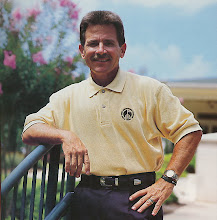Thatch is a layer of living and dead organic matter that occurs between the green matter and the soil surface. Excessive thatch (over 1/2 inch thick) creates a favorable environment for pests and disease, an unfavorable growing environment for grass roots, and can interfere with quality golfing conditions.
The primary component of thatch is turfgrass stems and roots. It accumulates as these plant parts buildup faster than they breakdown. Thatch problems are due to a combination of biological, cultural, and environmental factors. Cultural practices can have a big impact on thatch. As thatch levels accumulate to greater than 1/2 inch, turf problems may begin, and the thatch needs to be controlled. .
Below, once again you can see the thatch layer between the bottom of the turf and the gray colored soil. The area is dense and tangled and attracts insects and is a haven for disease occurrence. In dry periods this layer keeps water from getting deeper into the soil and to the roots where the plants can utilize the water. During wet periods the thatch acts like a sponge and hold water reducing the ability for the turf to drain.
The soil probe photo below shows another of undesirable and excessive thatch in a turf.Fairway aerification is implemented to reduce thatch and have firmer and drier turf surfaces
Aerification plugs are "chopped-up"
The tufts of grass left from the aerificaiton & the chopping process are blown together for collection & removal
Sand topdressing is then applied to the turf.
A brush or steel drag mat is then used to drag the sand into the aerification which aides in providing channels for better surface drainage and oxygen exchange to the roots as well as reducing thatch levels.
How does thatch affect turf quality?
An excessive thatch layer (more than 1 inch) can restrict the movement of air, water, fertilizer and other materials to the roots. This air- and water-impervious layer causes the grass to restrict rooting to the thatch layer which in turn reduces drought resistance in the turf. Additionally, if the thatch dries out, it becomes very difficult to re-wet with out the use of wetting agents or mechanical manipulation.
An excessive thatch layer (more than 1 inch) can restrict the movement of air, water, fertilizer and other materials to the roots. This air- and water-impervious layer causes the grass to restrict rooting to the thatch layer which in turn reduces drought resistance in the turf. Additionally, if the thatch dries out, it becomes very difficult to re-wet with out the use of wetting agents or mechanical manipulation.








